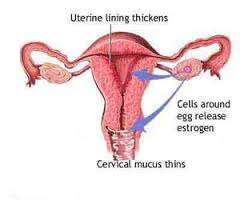Leukorrhea
Leukorrhea or (leucorrhoea British English) is a thick, whitish or yellowish vaginal discharge.[1][2][3] There are many causes of leukorrhea, the usual one being estrogen imbalance. The amount of discharge may increase due to vaginal infection, and it may disappear and reappear from time to time. This discharge can keep occurring for years, in which case it becomes more yellow and foul-smelling. It is usually a non-pathological symptom secondary to inflammatory conditions of vagina or cervix.[4]
| Leukorrhea | |
|---|---|
 | |
| Diagram showing leukorrhea infection | |
| Specialty | Synonyms = Fluor albus, Whites |
Leukorrhea can be confirmed by finding >10 WBC under a microscope when examining vaginal fluid.[5]
Vaginal discharge is normal, and causes of change in discharge include infection, malignancy, and hormonal changes. It sometimes occurs before a girl has her first period, and is considered a sign of puberty.
Types
Physiologic leukorrhea
It is not a major issue but is to be resolved as soon as possible. It can be a natural defense mechanism that the vagina uses to maintain its chemical balance, as well as to preserve the flexibility of the vaginal tissue. The term "physiologic leukorrhea" is used to refer to leukorrhea due to estrogen stimulation.[6]
Leukorrhea may occur normally during pregnancy. This is caused by increased bloodflow to the vagina due to increased estrogen. Female infants may have leukorrhea for a short time after birth due to their in-uterine exposure to estrogen.
Inflammatory leukorrhea
It may also result from inflammation or congestion of the vaginal mucosa. In cases where it is yellowish or gives off an odor, a doctor should be consulted since it could be a sign of several disease processes, including an organic bacterial infection (aerobic vaginitis) or STD.[7]
After delivery, leukorrhea accompanied by backache and foul-smelling lochia (post-partum vaginal discharge, containing blood, mucus, and placental tissue) may suggest the failure of involution (the uterus returning to pre-pregnancy size) due to infection. A number of investigation such as wet smear, Gram stain, culture, pap smear and biopsy are suggested to diagnose the condition.
Parasitic leukorrhea
Leukorrhea is also caused by trichomonads, a group of parasitic protozoan, specifically Trichomonas vaginalis. Common symptoms of this disease are burning sensation, itching and discharge of frothy substance, thick, white or yellow mucous.[4][8]
Treatment
Leukorrhea may be caused by sexually transmitted diseases; therefore, treating the STD will help treat the leukorrhea.
Treatment may include antibiotics, such as metronidazole. Other antibiotics common for the treatment of STDs include clindamycin or tinidazole.[9]
Etymology
The word leukorrhea comes from Greek λευκός (leukós, “white”) + ῥοία (rhoía, “flow, flux”). In Latin leukorrhea is fluor albus (fluor, "flow" & albus, "white").
References
- "leukorrhea" at Dorland's Medical Dictionary
- "Definition of LEUKORRHEA". www.merriam-webster.com. Retrieved 2015-12-20.
- "Hormonal effects in newborns: MedlinePlus Medical Encyclopedia". medlineplus.gov. Retrieved 2018-11-07.
- "leukorrhea | medical disorder". Encyclopædia Britannica. Retrieved 2015-12-20.
- Workowski, Kimberly A., and Stuart Berman. "Sexually Transmitted Diseases Treatment Guidelines, 2010." Centers for Disease Control and Prevention. Centers for Disease Control and Prevention, 17 Dec. 2010. Web. 28 Oct. 2014. <https://www.cdc.gov/mmwr/preview/mmwrhtml/rr5912a1.htm>.
- Behrman, Richard E.; Kliegman, Robert; Karen Marcdante; Jenson, Hal B. (2006). Nelson essentials of pediatrics. St. Louis, Mo: Elsevier Saunders. p. 348. ISBN 978-1-4160-0159-1.
- "leukorrhea". Cite journal requires
|journal=(help) - Dhami, P.S (2015). A Textbook of Biology. Jalandhar, Punjab: Pradeep Publications. pp. 1/79.
- "Treatments for Specific Types of Sexually Transmitted Diseases and Sexually Transmitted Infections (STDs/STIs)." Treatments for Specific Types of Sexually Transmitted Diseases and Sexually Transmitted Infections (STDs/STIs). Eunice Kennedy Shriver National Institute of Child Health and Human Development, n.d. Web. 28 Oct. 2014. <http://www.nichd.nih.gov/health/topics/stds/conditioninfo/Pages/specific.aspx>.
External links
| Classification |
|---|